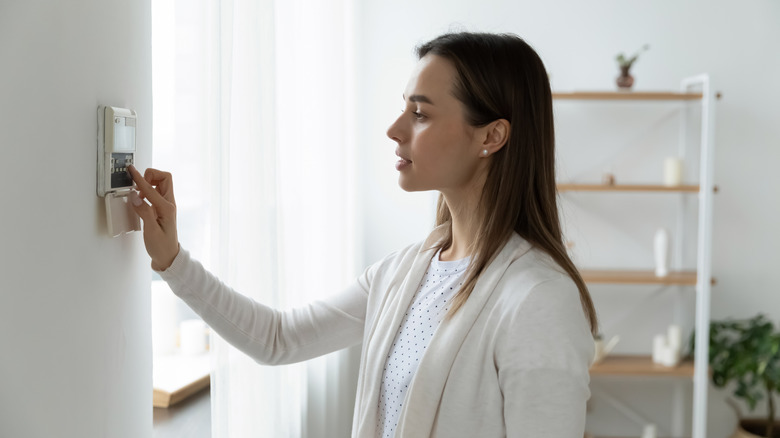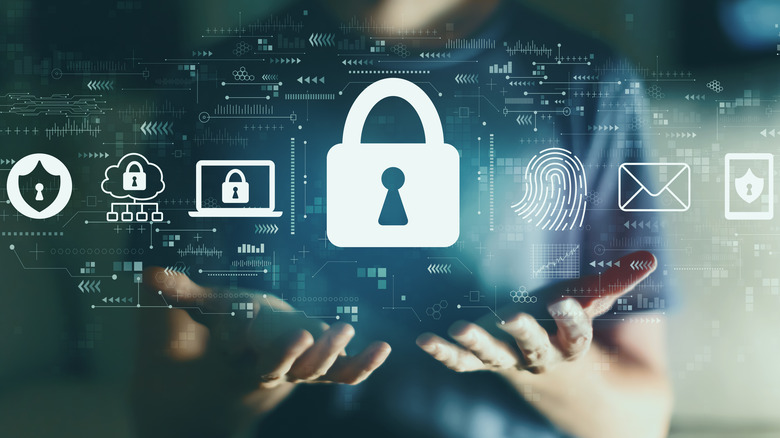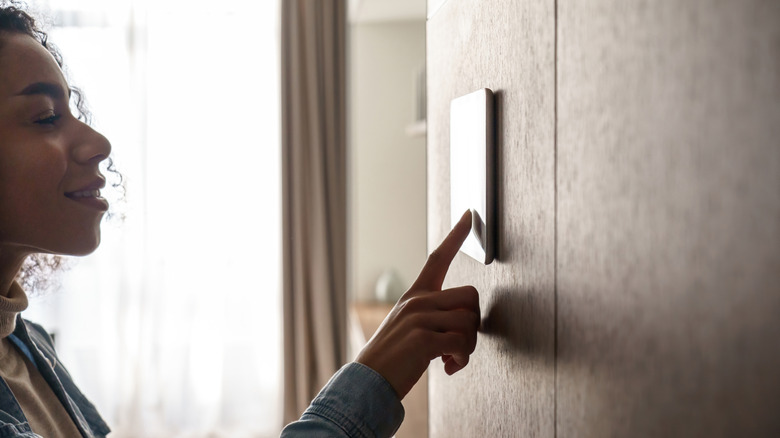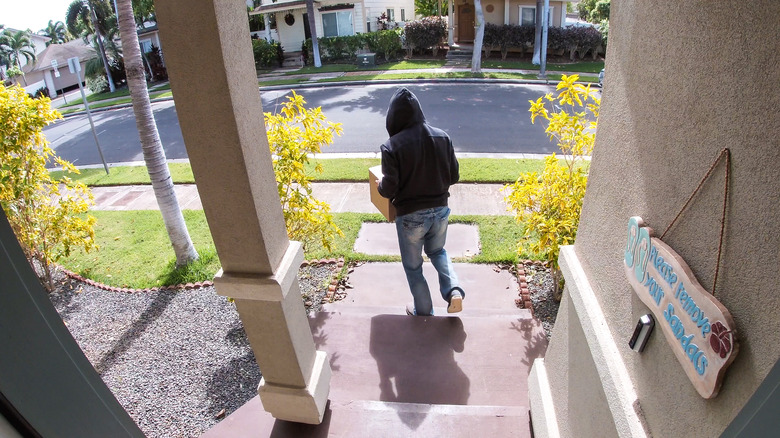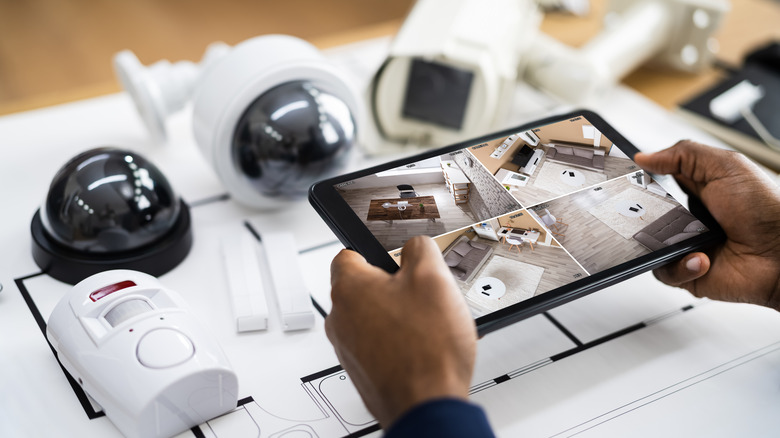How Much Does It Cost To Install A Security System?
Installing a security system in your home is an excellent option for anyone worrying about neighborhood safety and the overall level of protection that their house and its belongings enjoy. Security systems come in many configurations and packages, so selecting one that meets your needs will take some research but is actually far more approachable than you might initially think. As U.S. News & World Report suggests, home protection and family safety are consistently ranked as the most important factors for families that install a new security system or maintain existing protections for their houses.
Although statistics show a decreasing volume of residential property crimes year over year, the inclination to protect your belongings and loved ones is a powerful one — and it's something that truly shouldn't be ignored. Regardless of your community's relative security, a lack of security monitoring can act as the difference maker between a burglarized home and a house that would-be criminals pass over. Forbes Advisor reports that a home security system's overall costs should be broken down into three primary categories, and these expenses typically tally up to a price tag ranging from $199 to $598 (not including a varying monthly service charge for professional monitoring that typically sits between $25 and $50 per month).
Factors for cost
The most important facets of a security system in terms of cost center on the equipment. Security systems typically use entryway monitoring, motion sensors and lighting options, and extreme change detection (such as flood or fire alerts). Depending on the size of your home and the particulars of the system you wish to install, the price can range across a vast scale. Typically, breaking security solutions into two primary categories is the best way to understand your home's needs. There are security solutions that act as a means of deterrence and others that seek to push bad actors toward the least objectionable outcomes and mitigate damages once a breach has occurred (in simpler terms, they have some sort of trap behind the walls). Working with a security service to understand the logistical needs of your house and best practices for your community more broadly is a great way to understand the particular blend of solutions that can provide the best protection for your home and family.
Entry alert solutions are the bread and butter of the home security environment
This Old House recommends using smart locks and sensors on all access points, particularly on the first floor, as 79% of break-ins use doors and windows on the first floor to gain enter a property. Sensors and corresponding alert systems are damage mitigation solutions, with many homes using an alarm to bring about a rapid response in the event of a break-in. This comes in the form of an intense alarm sound, and a rapid police response called out by the security company that handles the monitoring of your system. Forbes Advisor estimates pricing surrounding a few major names in the security space, reporting: $37 to $53 per month from ADT, $30 to $50 per month with Vivint, $199 to $599 for the equipment and installation of an Amazon Ring system, plus a $10 monitoring fee per month, and Frontpoint security monitoring from $45 to $50 per month.
Lighting upgrades help deter intruders and promote a safer environment
Another essential upgrade is the use of strategic lighting throughout your property. A great option for any homeowner looking to make a big change in this area is the use of motion-activated exterior lighting. Quality lighting with pre-built motion-sensing technology will run the price gamut; still, a quick survey of marketplaces provides a range of options that can start at around $15 per fixture and rise to as much as $600 for a fully integrated solar-enabled floodlight (with the majority of options falling between $25 and $100 per light fixture). Waldon Security reports that lighting can offer homeowners a varied approach to threat mitigation by suggesting activity inside the house while ensuring that security cameras can capture clear images of any intruders attempting to enter a property. The firm also suggests that you can use lighting to hide the presence of video monitoring equipment, making this inclusion a core component of deterrence efforts in your home.
Utah Lights points out that when used alone, a motion-activated lighting array provides only a single line of defense that offers no additional benefit once it has been breached. So instead, the Utah Lights team offers a model they call rings of security that appear as natural scene lighting that beautifies your exterior landscape. In reality, this approach to nighttime illumination creates a visual depth to the yard space extending beyond the four walls of your home. It also minimizes darkened areas that can be used for cover or approach angles to circumvent other measures (like video monitoring).
Security cameras offer state-of-the-art monitoring and deterrence solution
A security camera array offers a blend of both deterrence and use as an after-action remedy. Visible home cameras around the exterior of your property can provide a layer of protection just with their presence, which is perhaps why some residence and business owners opt to use fake cameras as a cheaper means of scaring off would-be criminals. However, if the smokescreen doesn't hold up to scrutiny by a burglar, chances are you're actually putting your home at greater risk since they will assume that your house is vastly under-protected, Netatmo.com notes. As for pricing, SimpliSafe and Cove camera packages start at just $244.96 and $249, respectively. External cameras that use cloud recording solutions can be tied directly into your existing wireless internet infrastructure and will effectively create a consistent monitoring solution that gives you and your family essential peace of mind.
Security cameras aren't just useful for preventing burglaries, though. For instance, an interior camera setup, or one that is rear-facing and covers a property's pool deck, can play an integral role in preventing injuries to children and pets. In addition, a security camera that utilizes the same push alert technologies that make Ring doorbells so popular can be the difference-maker between a calamity and fast action that saves a life.
Additional costs
Installation and monthly service costs are the only additional considerations to be made once you've selected the appropriate security infrastructure for your home.
Installation can range from zero-cost to substantial
Homeowners will always hold their own particular requirements for security systems, so it can be difficult to judge the installation costs relative to experiences shared by neighbors or friends. Many homeowners can do a simple camera mount and smart doorbell fitting. But when it comes to wired systems that link into a central unit in the kitchen or entry hallway, it's often a good idea to hire a professional to conduct the installation tasks. Installation pricing can range across a wide gap (via Forbes Advisor). Some companies will set up sensors and cameras for free, while others may charge up to $199 for a standard installation. Shopping around is always a great idea: Comparing installation pricing alongside the potential costs for equipment and monthly monitoring charges can illuminate the best overall bargain for your home security needs.
Factor monthly service charges into the equation for a complete picture
Forbes Advisor reports that prices for monitoring services can range from as low as $10 per month to around $50. Comparing features like response time, promotional rates, and other value additions can help you select from the field of options in the home security world. SafeWise offers a table that breaks down these prices from some of the leading brands, citing the lowest prices for monitoring: ADT from $27.99 per month, Cove at $17.99 per month, SimpliSafe offering coverage from $17.99 per month, Frontpoint listed at $34.99 per month, and Vivint at $29.99 per month.
Typical security system features and functionalities
A security system starts with entryway monitoring and the addition of a sign in the front yard. Still, state-of-the-art installation often utilizes cloud relays and wireless connectivity to provide uninterrupted uptime.
Wireless installations provide flexibility and easy access for maintenance and future upgrades
Homeowners must select a system built on either a wired or wireless infrastructure. Both provide a series of benefits, but many now opt to install wireless monitoring solutions because they are much easier to install and can be fitted by a handy homeowner in some instances. Wireless systems are built for the modern world and use high-end connectivity measures that can help you maintain a real-time video, review sensor alerts, and more.
With smart doorbells and locking mechanisms that many companies now offer in the security marketplace, homeowners can set up push alerts on their mobile phones to verify delivery, let a pet sitter into the house, or even shout at a burglar to startle them and thwart a break-in. In addition, many brands have rolled out combination packages that provide both of these features, with smart locks on their own averaging at around $250 (via Digital Trends).
Security cameras are typical these days
Most houses that incorporate video surveillance will make use of two to six external cameras, according to Nelly's Security. It's best to install these devices in an arrangement that allows for overlapping coverage. Many homeowners will seek to position cameras to capture multiple areas of the property; and while complete coverage isn't always necessary (perhaps an empty space that runs a section of the home's side yard), leaving a blind spot in an area that includes a door or window is a major no-no.
Glass-break sensors provide an additional layer of defense
A sensor detecting broken window panes will elevate your security system to a great height. These sensors typically work with shock or sound detection methods (via Security.org), and a single device can often cover an entire room. Broken glass detection is a quality defense against break-ins. Still, it can also alert you to damage from high winds and other natural occurrences if you're away for business or vacation or in the event of an evacuation due to tornado, hurricane, blizzard, or other local weather advisories (which should always be taken extremely seriously).
Why you need a security system
A security system is the first line of defense for home protection against burglary, fire, and other plagues that can harm your household, U.S. News & World Report notes.
Deterrence is the preeminent feature of any good home security system
The FBI reported that burglaries cost an average of $2,661 per victimized house in 2019. Likewise, according to Forbes Advisor, a 2017 study by the U.S. Department of Justice reported that 1.7 million burglaries occurred in 2017, with almost 425,000 taking place during the day — specifically during typical business hours that traditionally see homeowners away from their properties.
The financial toll of a break-in alone is enough to drive homeowners toward the decision to install a new security system or beef up their existing coverage elements. But, to make matters direr, Pew Research Center reports that only 13% of burglaries are solved, meaning that a homeowner looking to win the battle against a break-in realistically must do it at the point of contact rather than after a theft has occurred. Installing visible and powerful security measures offers the best approach to this mission for a homeowner in any corner of the country and across various local community layouts and environments.
Fire prevention and automatic call-outs protect your home from myriad threats
One of the main performance functions of a home security system is the ability to call local authorities to the property on your behalf. As a result, security companies spend much of their efforts building a robust backend system that can address identified threats in real-time and provide an appropriate response as quickly as possible (via SafeHome.org). A home protection service can mean the difference between a contained fire or other disaster and one that consumes your entire house in extreme circumstances. Quick action is one of the most critical features of any monitoring system, and it serves in several crucial roles that expand beyond the involvement of police services designed to mitigate the risk of theft.
Benefits of a home security system
From monitoring that covers criminal activity to natural threats in the house, installing a security system can provide a powerful baseline of comfort and ease on your property.
A security system can reduce your insurance costs
According to SafeWise, installing a security system can reduce your homeowner's insurance payments by up to 20%. In addition, PolicyGenius reports that most insurance companies offer a standard discount rate for homeowners who have a system added to their property, although the amount can vary. After installing a security system, it may be a good idea to shop around for coverage with a new provider to compare quotes and discount offers. CNBC also advises all consumers to incorporate homeowner's insurance into their calculation of typical expenses while conveying that average premiums cost homeowners an average of $1,200 per year (or $100 each month). With a new system installed, comparing rates and taking these data points back to your current insurance provider can give you leverage to minimize payments without making any substantial changes.
Smart systems can provide remote access to various services
With digital connectivity as a primary functionality of new security systems, many brands incorporate utility monitoring and additional switching features as an ingrained feature of the platform (via PC Mag). A new security system creates peace of mind in your home, but it can also provide a blueprint for streamlining the manual tasks you've always performed as you prepare to leave the house for a long weekend or even just a routine day out at the office. In addition, the ability to incorporate smart switches, water heaters and consumer electronics, and more into your house's system can give you a new level of feature integration that makes life easier than ever before.
Home security is a staple of modern homeownership
A home security system is an addition that brings a unique sense of calm and safety to any residence. For a homeowner looking to shore up weak points in their home environment, the cost of a home security installation is often viewed as a minuscule expense when weighed against the benefits that the monitoring and alarm systems can provide. According to Security.org, only around 30% of U.S. households use a security system. Unfortunately, all it takes is one incident in an unmonitored house to provide a painful lesson in the value of this security blanket. Making use of this home planning and protection utility is often well worth the cost.
